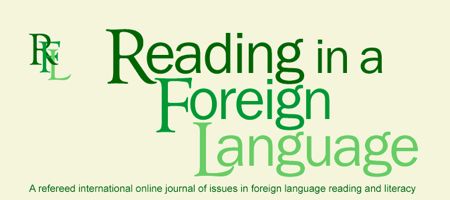
The April 2019 issue (Volume 31, Number 1) of the electronic journal Reading in a Foreign Language (RFL) is now online.
This issue of RFL has six regular articles featuring both quantitative and qualitative studies from Japan, South Lebanon, China, Thailand, and New Zealand. In the first, Natsuki Aka examines the effects of a year-long extensive reading program on the development of language knowledge and reading abilities with learners of English in Japan. Findings reveal that the scores of the middle and lower proficiency groups increased significantly. In the second article, Gazi Ghaith and Hind El-Sanyoura tested the mediating role of metacognitive strategies with L2 readers and found that problem-solving strategies positively associated with literacy and high-order reading comprehension. In the next article, Huan Liu, Cindy Brantmeier and Michael Strube examine the multidimensionality of the reading-writing relationship in EFL test preparation in China. Findings indicate that reading comprehension was a significant predictor of descriptive writing performance, regardless of level of instruction. Next, John Macalister and Stuart Webb attend to the challenge of managing the transition from the reading of top-level graded readers to authentic texts. The authors report that the use of L1 children’s literature is a possibility for the EFL classroom because of the high coverage of word families. In the fifth article, Savika Varaporn and Pragasit Sitthitikul report positive effects of the use of multimodal tasks in critical reading test scores, and more specifically, the researchers find that multimodal tasks enhance intrinsic motivation and learning autonomy. In the last article, Zhiying Zhang and Stuart Webb provide evidence that bilingual books may be a useful tool for vocabulary learning, with gains in vocabulary greater through reading bilingual texts and glossed texts than for reading the English-only text.
There are two book reviews in this volume. Andrew John Wilkins reviews Website Xreading. Next, Ceyhun Yükselir reviews Teacher Development in Technology-Enhanced Language Teaching by Jeong-Bae Son.
RFL is a scholarly, refereed journal published on the World Wide Web by the University of Hawai`i, with Richard R. Day and Cindy Brantmeier as the co-editors, Thom Hudson as associate editor, and Xiangying Jiang, West Virginia University, as the reviews editor.
The journal is sponsored by the National Foreign Language Resource Center (NFLRC), the University of Hawaiʻi College of Languages, Linguistics and Literature, and the University of Hawaiʻi Department of Second Language Studies. The journal is a fully refereed journal with an editorial board of scholars in the field of foreign and second language reading. There is no subscription fee to readers of the journal. It is published twice a year, in April and October. Detailed information about Reading in a Foreign Language can be found at http://nflrc.hawaii.edu/rfl.
